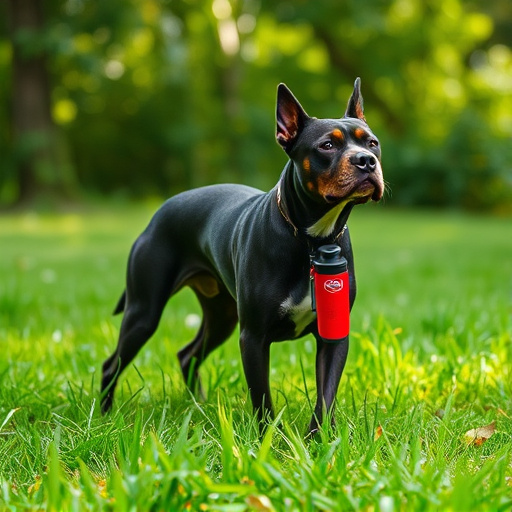Dog aggression is often fear-, stress-, or anxiety-driven, triggered by various factors. Animal pepper spray with a 3-10 feet effective range can deter aggression by temporarily irritating dogs' eyes and noses. Legalities vary; always check local laws and use as a last resort for self-defense. Products like Effective Range Animal Pepper Spray use capsaicin to incapacitate attackers at close range (2-3 meters). Training, behavior modification, and strategic spray usage prevent dog attacks, ensuring safety around dogs in various environments.
Dog attacks can be devastating, but preventing them is possible. This guide explores powerful tools and techniques to safeguard yourself and your loved ones from potential dog aggression. We delve into understanding triggers that ignite dog attacks, navigating legal boundaries surrounding animal pepper spray use, and selecting the ideal pepper spray for effective deterrence within its impressive range. Additionally, we uncover application methods, safety precautions, and behavioral strategies to ensure a proactive approach to dog attack prevention.
- Understanding Dog Aggression Triggers
- Legal Considerations for Pepper Spray Use
- Choosing the Right Pepper Spray for Dogs
- Application Techniques and Safety Measures
- Training and Behavior Modification Strategies
Understanding Dog Aggression Triggers
Dog aggression can stem from a variety of triggers, and understanding these is crucial for preventing attacks. One of the primary factors is fear; dogs may react aggressively when they perceive a threat to their territory or well-being. Unexpected movements, loud noises, or unfamiliar people or animals can all elicit this response. Additionally, some dogs display aggression as a result of stress or anxiety, often stemming from lack of socialization or past traumatic experiences.
Recognizing specific scenarios that trigger aggressive behavior is essential for taking preventive measures. For instance, using an animal pepper spray with an effective range can deter aggressive dogs by temporarily irritating their eyes and nasal passage, giving the owner time to retreat or defuse the situation. By understanding these triggers and employing appropriate strategies, including the responsible use of pepper spray, individuals can enhance their safety around dogs and promote positive interactions.
Legal Considerations for Pepper Spray Use
The legal landscape surrounding pepper spray use for dog attack prevention varies significantly across jurisdictions. In many regions, civilian use of pepper spray against dogs is allowed under specific circumstances but comes with stringent rules and restrictions. Key considerations include ensuring the spray is used as a last resort to protect against imminent physical harm, as well as adhering to local laws that dictate permitted application methods and effective range.
Animal pepper spray must be distinguished from other types for legal clarity. Regulations often stipulate the concentration levels suitable for animal deterrence while minimizing risk to human health. Understanding these legal nuances is crucial for responsible use, avoiding potential charges of animal cruelty or unlawful assault, and ensuring the product remains an effective deterrent within defined boundaries.
Choosing the Right Pepper Spray for Dogs
When selecting dog attack prevention pepper spray, it’s crucial to consider factors like effective range and active ingredients. The effective range of animal pepper spray varies significantly, typically ranging from 3 to 10 feet. Opting for a spray with a range that suits your needs, whether you’re in a remote area or close to urban spaces, is essential. Ingredients such as capsaicin, the primary compound in chili peppers, are known to be highly effective in deterring dogs.
Additionally, checking the concentration level of capsaicin can provide insights into the spray’s potency. Higher concentrations offer more protection but should be used cautiously around children and other pets. Always read product labels and instructions thoroughly before purchasing to ensure you’re getting a reliable and safe solution for dog attack prevention.
Application Techniques and Safety Measures
Effective range animal pepper spray is a powerful tool for self-defense against dog attacks, but its success relies on proper application techniques. Hold the can upright and target the attacker’s face, eyes, and nose, as these areas are highly sensitive to capsaicin, the active ingredient in pepper spray. A quick burst at close range (typically 2–3 meters or 6–10 feet) is most effective, creating a temporary incapacitation that allows you to escape.
Safety measures are paramount when using animal pepper spray. Always ensure you have a clear path to safety before deployment. Avoid aiming towards the eyes of non-aggressive animals or people by mistake, as it could cause discomfort or injury. Store pepper spray out of reach of children and pets, and check local laws regarding its use, as regulations vary by region.
Training and Behavior Modification Strategies
Training and behavior modification strategies play a pivotal role in dog attack prevention, especially when coupled with the effective use of animal pepper spray. Through positive reinforcement, owners can teach their dogs to associate certain commands or actions with rewards, helping them gain control during potentially aggressive situations. This involves consistent training sessions that focus on desensitizing the dog to triggers that might incite an attack.
Behavior modification techniques, such as counter-conditioning and desensitization, involve gradually exposing the dog to the stimuli that provoke aggression in a controlled and safe manner. Over time, this reduces their fear response and replaces aggressive behavior with calmer reactions. Combining these strategies with the strategic use of animal pepper spray within its effective range can significantly enhance overall safety measures against potential dog attacks.
Dog attack prevention through the strategic use of animal pepper spray can be an effective tool, but it’s crucial to understand its limitations. By addressing triggers, ensuring legal compliance, and selecting the right product with proper application techniques, individuals can enhance their safety in potential dog encounter scenarios. Combining this method with training and behavior modification strategies offers a multi-faceted approach to minimize risks from dog aggression. Remember, knowledge, preparation, and responsible use are key when considering pepper spray as part of your personal safety arsenal.
